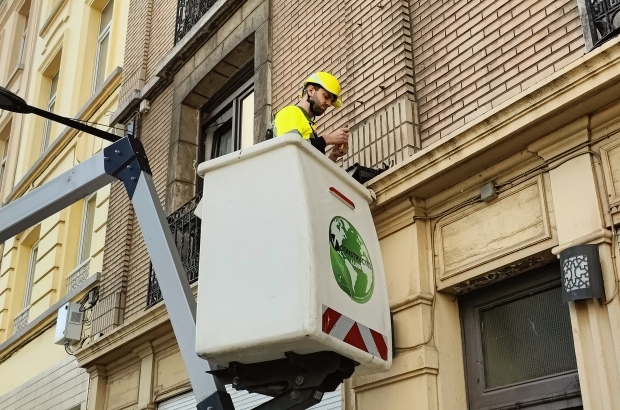- Daily & Weekly newsletters
- Buy & download The Bulletin
- Comment on our articles
Thousands of newly installed fibre-optic boxes need replacing
Telecom operators Digi and Proximus have to replace thousands of fibre-optic internet distribution boxes on the facades of properties, not long after installing them because they do not comply with building regulations, according to Brussels secretary of state Ans Persoons (Vooruit).
The regulations stipulate that the boxes must have a similar colour to the facade, Bruzz reports, which is not the case for many of the boxes installed, which are typically black.
The new fibre-optic boxes are the result of internet providers Digi, Proximus and Orange building a fibre-optic network in Brussels. Digi, for example, has already installed black boxes at 150,000 premises.
These boxes have already been the recipient of much backlash, with Brussels residents reporting that they do not want the boxes and that the installations result in damage to their – in some cases historical – property.
The telecom operators said the rules were "unclear" about the obligation to match the boxes with the facade of the buildings, prompting Persoons to issue new guidelines to clarify the existing legislation.
Telecom companies will now be given a choice of three types of distribution boxes in black, grey or terracotta (for brick facades). If none of those three colours match a particular facade, cable layers will have to apply for planning permission – something they must do anyway when it comes to listed buildings and facades.
“The Commission for Monuments and Sites will always issue a negative opinion for that, so de facto there is a ban in the case of protected facades,” said Michaël de Borman, a citizen who launched a petition against the proliferation of illegal fibre-optic boxes – namely those installed against the objections of property owners and in violation of historical building protections.
Borman said that the new guidelines were not enough to keep telecom operators from quietly violating the law in expanding their fibre-optic network.
“Not only the distribution boxes but also the cables should be considered,” Borman said. “The region doesn’t currently do that – they don’t count the cables for the maximum size of a box and they don’t require cables to be in the same colour as the facade.”
Persoons said that asking for the cables to likewise blend into buildings’ facades is "unreasonable" and "unworkable", because one cable is often stretched over multiple facades.
Digi said it would respect the decision regarding the boxes’ colour and proceed with correcting thousands of improperly installed ones, according to general manager for Belgium, Jeroen Degadt.
“As a company, we have no problem with rules as such, but they have to be clear,” Degadt said.
“We thought we were not doing anything wrong and have always acted in good faith. We’ve already visited 150,000 out of 600,000 premises in Brussels, to give you an idea of the order of magnitude.”
If the telecom companies fail to replace boxes that violate the rules, they risk prosecution by the municipality or by the regional urban planning authority Urban.brussels.
Degadt denied accusations that Digi purposefully installed boxes on historically protected facades.
“On the many tens of thousands of premises we have already connected, it may have gone wrong a few times, that was not our intention,” Degadt said.
“We now have the lists of protected facades and where we made mistakes, we will correct them as soon as possible.
"But I do want to say that we have been vindicated in every complaint lodged with the regulator so far. We had the right to hang cables on those particular façades about which complaints came.”
Proximus, which has the largest fibre-optic network in Brussels, would not confirm whether or not it would replace tens of thousands of newly installed boxes.
“For new connections, it’s clear to us: we will install them from now on with adapted boxes,” said spokesperson Fabrice Gansbeke. “But for connections that have already happened, we are still waiting for the exact guidelines.”
Proximus has already connected 70% of Brussels households to their fibre-optic network.
“Replacing all those boxes is a titanic task,” Gansbeke said.
“We’ve already invested hundreds of millions in this infrastructure that is crucial for the digital future of Brussels, we think that should be taken into consideration.
"With such major works, it can sometimes happen that an occasional mistake is made. If we have effectively installed cables illegally on a listed facade, we will rectify it.”
Orange, which is currently installing fibre optics only in Ixelles, did not wish to comment until “the guidelines have been officially published by the regional administration”.















Comments
The locals are clearly paid by Proximus. How can you ask Digi to leave when Digi will offer for 10 euros what Proximus offers today for 50 per month? It is even funnier to talk about renting from Proximus.
Then let Proximus take down its boxes and cables, because as soon as Digi is working at full capacity, Proximus will be of no use to anyone. I am really looking forward to Digi, because they are cool!
And if we are going to clean the facades of houses, then we will clean them from old copper wires and antennas that are morally and physically obsolete. But not from Digi!